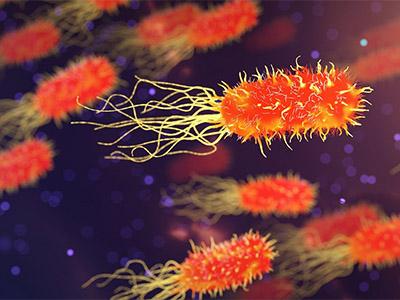Introduction
Food safety and public health are recognised as critically important issues for Scottish food production (Scotland’s National Food and Drink Policy, 2009). The Food Standards Agency estimate that in the UK, around 1million people per annum suffer foodborne illness, of whom 20,000 receive hospital treatment, with 500 cases resulting in death. The estimated economic cost is nearly £1.5bn. The emergence of new foodborne pathogens or toxins and the control of existing ones remains an important area for future research. Consultation with key stakeholders, including Food Standards Scotland (FSS) and industry highlighted the major areas of concern, including those with relevance to policy, such as the VTEC action plan and Acting on Campylobacter Together (ACT). As such, each of the systems under investigation in this research addresses priority areas or emerging issues for the key stakeholder groups, primarily food and public health agencies and reference laboratories in Scotland and the UK (FSS / FSA, HPS / PHE).

Aim of Research
The focus of the work is on microbial contaminants of food, either directly or via toxins, and heavy metal contaminants. The work will define risk factors and improve detection of the most important food-borne pathogens, toxins and heavy metals, and will examine the flow of antimicrobial resistance through the food and into the commensal microbiota, all of which will contribute to improved public health in Scotland through uptake by stakeholders in public health and the food industry. The work is split into two objectives: the molecular detection and diagnosis of pathogens and risk-based analysis.
Progress
2021 / 2022
Work within this objective has focussed on important aspects of food safety, examining microbial and chemical contaminants, and focussing on two objectives: the molecular detection and diagnosis of pathogens and risk-based analysis. MALDI mass spectrometry was successfully used for typing foodborne pathogens, and also for facilitating the rapid identification of antimicrobial resistance in foodborne bacteria. Screening of antimicrobial resistance genes identified highly similar genes in animal faeces, pathogenic Campylobacter isolates and human commensal bacteria, flanked by identical putative mobile DNA sequences. Developmental growth stages of plants were found to impact colonisation by STEC O157:H7. Crops grown as 'microgreens/microleaves' were found to be colonised similarly to sprouted seeds, with species-dependent differences. Project outcomes were linked to an industry linked KTP project to generate growers tools to assess microbiological risks.
Mycotoxin contamination was frequently found in Scottish cereals, particularly in oats. Food samples were found to contain low mycotoxin levels which resulted in human exposure, mostly at safe levels, but children and high cereal consumers are at risk of high exposure. Work on heavy metal contamination enhanced the understanding of chemical contaminants within the Scottish food chain and has enabled stakeholders to assess risks, identify mitigation strategies and inform consumers and industry.
Year 6 EU-Exit work developed a liquid chromatography method to investigate contaminating levels of antimicrobial residues in food stuffs. However, the screen was not sensitive enough to detect the low levels corresponding to the maximum permitted residue limits, even though resistance genes to some antibiotics had been detected in the same foods. Work also focused on developing a more sensitive, reliable, and ethical method for detecting Toxoplasma gondii in meat to replace the mouse bioassay. Although primers were able to distinguish between viable and non-viable parasites, the method was not suitable for application to meat samples.
All projects have been successfully completed and important findings have been disseminated to FSS and other relevant stakeholders. Work from this RD has also informed future projects within AMR, microbial and chemical food contaminants and risk analysis funded within the next RESAS SRP.
Highlights
Mycotoxin contamination of cereals grown in the UK is of major concern for growers, processors and regulators. An SRP researcher was invited to present SRP research on mycotoxins and masked mycotoxins in human nutrition, at a UK arable mycotoxin stakeholder forum and has recently been appointed to the FSA Scientific Advisory Committee on Toxicity of Chemicals in Food, Consumer Products and the Environment (COT) to provide scientific advice and expertise on dietary exposure assessment and chemical contaminants in the food chain for FSA, the UK Department of Health and other government bodies.
A data analysis pipeline for MALDI mass spectrometry spectra, which can be applied in the identification of markers of antimicrobial resistance, was developed and released as an open-source package.
Two short educational animations were created, focussing on the role of microbes in a healthy gut and the importance of a healthy, balanced diet.
2020 / 2021
Work within the Food safety objective continues to generate evidence on issues related to microbial and chemical hazards within the food chain. Projects have provided valuable insights into important food pathogens, developing rapid detection methods, assessing AMR carriage through the food system and ranking of risks posed by different pathogens. Analysis of chemical food contaminants included major compounds such as mycotoxins, heavy metals and arsenic in a range of Scottish products from seafood to cereals. Findings are continuously communicated to policy end users and industry stakeholders to identify key intervention points which will improve food safety standards. Some work in this objective has been delayed due to lab closures and research activities will continue into year 6.
Highlights
Factors in horticultural crops were identified that impact adherence and colonisation of the foodborne pathogen STEC (O157:H7), and so inform on risk assessment.
Theme researchers set up an interactive educational website focussed on microbes, food and health, Microbe Safari, which contains detailed information on microbes and how they relate to gut health, food safety, food production and the environment. The website aims to engage the general public and school children, and had input and support from FSS.
Key papers build on a track record of output on food-borne toxins: (i) the dietary exposure of UK children to multiple mycotoxins from foods showing that safe levels of intake are frequently exceeded, and (ii) how different edible plants and plant extracts impact the growth response of food poisoning organisms, such as Shigatoxigenic Escherichia coli and its common O157 (and less common non-O157) serotypes. A paper was also published reporting the presence of Toxoplasma gondii in retail meat samples for human consumption, highlighting a potentially significant risk to public health.
An understanding of the impact of plant factors on the ability of STEC to grow and establish is required for food safety and risk assessment. In recognition of this expertise, a researcher joined the UK Food Standards Agency Register of Specialists: ‘Food safety – chemical contaminants & additives’.
2019 / 2020
Detection of microbial, toxin and chemical hazards has been extended to a wide range of foodstuffs, from cereal to meat products. This demonstrates the continued need for surveillance as well as awareness campaigns. As such, deliverable owners continue to work with key Scottish stakeholders to disseminate the major findings. Antibiotic resistance is a global health concern, and work here has demonstrated the value for detection methods, as well as the underlying mechanisms, for priority foodborne microbial pathogens. Risk analysis approaches for other microbes have shown that an apparent antimicrobial property in edible plant species does not inhibit pathogen growth.
Highlights
Scottish AMR research on an International Platform: Work on the influence of selective pressure on the spread of antimicrobial resistance (AMR) (‘Impact of antimicrobials on gut bacteria’) was presented at the Annual Microbiology Society meeting (Apr-19) and will contribute to a meeting linking to WPs 2.3 and 2.2. AMR is one of the principle drivers in microbiology bioscience, worldwide. Cross-RD coordination will support a Scottish perspective, which can then be used on an international platform, e.g. for the 2020 One Health Congress.
Work from the deliverable was presented and discussed during the SEFARI Gateway-funded workshop ‘Scotland’s Diner Plate 2050’, discussing the future of food production and aspects relating to Food Safety.
2018 / 2019
Work continues to accumulate primary data that ultimately feeds into risk management approaches for a variety of food-borne biological, toxin and chemical hazards, relevant to Scottish food production. The work adds data on surveillance and detection in foodstuffs, and characterises known hazards in association with their foodstuffs. The work covers priority pathogens and food issues for Scotland, and we continue to work closely with stakeholders such as Food Standards Scotland for knowledge exchange and dissemination.
Highlights:
Mycotoxin workshop: Building on SRP and SG-funded research, a workshop to discuss mycotoxin monitoring and potential areas of concern in a Scottish and UK context was jointly organised by Food Standards Scotland and the Rowett Institute (May 2018), bringing together representatives from industry, science and government. Discussion (see report) focussed on Fusarium mycotoxins - the most relevant toxins in terms of UK primary agricultural production, and the challenge of monitoring imports following Brexit.
2017 / 2018
Work on molecular detection of pathogens has led to detection of genes relating to antimicrobial resistance in a range of food commodities and modelling of their transfer in a livestock farm setting. In addition, methods have been developed to aid in the rapid detection of the main source of bacterial food-borne disease in Scotland (Campylobacter). Work focused on risk-based analysis has generated data for parameters relating to food-borne bacteria in fresh produce, mycotoxins in cereal-based products and parasites in meat products. Together the data will help to assign relative risk for each system.
Highlights:
A FSA-RESAS co-funded study has shown that plant-bound mycotoxin metabolites are not absorbed in the gut, but will contribute to risk following microbial release in the human large intestine [Gratz et al. 2017 Mol Nutr Food Res 61 (4), 1-10.], leading to change in policy by EFSA and recommendations [EFSA Journal 2017;15(4):4751].
A research publication on novel approaches for data analysis to help in rapid pathogen detection (https://doi.org/10.1093/bioinformatics/btx628)
Royal Highland Show 2017 exhibits (June 22-25) themed around ‘Microbes & Your Food’, with an interactive exhibit for the education centre (RHET), covering microbial interactions in food production, digestion and pathogen detection, and a SEFARI joint exhibit that engaged with primary producers (livestock & arable), public health workers (e.g. clinicians, nurses) and policy-makers (SG, food safety agency).
A keynote presentation on ‘Food and Waterborne Protozoa: a veterinary and public health perspective’ was given at ApiCOWplexa (October 2017, Madrid) (http://www.apicowplexa.net/wp-content/uploads/2019/03/apicowplexa2017_abstractbook.pdf)
2016 / 2017
The food safety objectives cover a range of targets from food-borne parasites, bacteria, fungal toxins and antimicrobial resistance genes. All of these issues are contemporary and although not specific to Scotland, they are considered priority areas by vested stakeholders in public health and food production. Our work is split into two main objectives: detection and diagnostics, and understanding the public health risk. New chemo-analytical methods have been developed for fungal mycotoxins and for the identification of Campylobacter and E.coli strains, including the verocytotoxin-producing Escherichia coli which cause infectious gastroenteritis. Associated bacterial genomic analysis is also being performed to correlate with the chemical microbial typing data and to establish evolutionary relationships between these problematic bacteria. Molecular biological diagnostics have been developed to antibiotic multiple resistance (AMR) genes and are being tested to establish their validity and robustness before trialling against food and livestock samples. Allied to this a model has been developed to study the flow of these AMR genes in the soil (bacteria) and this will be developed and refined as more data is generated throughout the project. Related to this is the ground breaking research showing that these damaging bacteria can survive in crops in field and through the supply chain, not just in humans and livestock. The science around this is being elucidated and this will have implications for full supply and value chain safety protocol development.
Future Activities
MALDI mass spectrometry successfully developed in this SRP for typing foodborne pathogens and methods will be applied in surveillance studies within Diet and Food safety (MRI-B6-1) and Biodiversity (MRI-D4-2) of the 2022-27 SRP.
Screening of antimicrobial resistance genes will continue in the new programme focussing on comparing the carriage of transferable antibiotic and heavy metal resistance genes within members of the resident anaerobic microbiota from diverse hosts and pathogenic bacteria. This will take place in projects within Animal disease (RI-A2-02) and Diet and Food safety (RI-B6-01).
Project outcomes appraising E. coli O157:H7 and Salmonella interactions with plant produce were linked to an industry-linked KTP project to generate growers tools to assess microbiological risks and inform future projects (SRUC-B6-1; SRUC-B6-2). The growers tool was used by the company as part of the risk management package for their customers, and the risk assessment is being adapted for AMR bacteria, and for additional primary production systems.
The foodborne parasite Toxoplasma gondii has been found in venison, pork, lamb, and chicken but not in beef. Future work will investigate the genetic diversity of T. gondii in food animals as well as mitigation strategies to reduce foodborne transmission to humans (MRI-B6-1).
Mycotoxins were frequently detected in Scottish cereals and cereal foods at low levels, but human exposure still occurs. Future work (RI-B5-1) will focus on how to minimise mycotoxin contamination in cereals and hence reduce the risk of exposure in consumers.
Aspects of the work aimed at creating a greater evidence base regarding heavy metal and iodine levels in Scottish seaweeds/seaweed products and the potential risks to public health will be continued in the new RESAS programme (R-:B7-05).
Selected Outputs
KE outputs coordinated with another RD (2018-19):
- A talk entitled “E. coli O157:H7 – Watch out for the salad, as well as the undercooked beefburger!” was presented to the Microbiology Society at the University of Strathclyde on 10/10/2019
- A stakeholder day was arranged (14/05/2019) on the future of food production 'Scotland’s Plate 2050'; a SEFARI-funded project developing educational resources (end Mar-19) is due to be launched during 2019
-
Work on antibiotic resistance in Camplyobacter jejuni was presented during the International CHRO meeting: CHRO 2019 held in Belfast from 8 – 11 September 2019. (CHRO – Campylobacter, Helicobacter and Related Organisms).
-
A workshop meeting was organised and chaired ‘Dietary mycotoxin exposure in India and possible link to chronic diseases’. National Institute of Nutrition, Hyderabad, India, June 2019. https://www.nuffoodsspectrum.in/news/46/5188/nin-conducts-workshop-on-dietary-mycotoxin-exposure-in-india.html
-
Membership of the UK Food Standards Agency Register of Specialists (Food safety – chemical contaminants & additives, since 2019) https://www.food.gov.uk/about-us
Publications and other outputs
2016/17
Masked trichothecene and zearalenone mycotoxins withstand digestion and absorption in the upper GI tract but are efficiently hydrolysed by human gut microbiota in vitro. (2016) – a paper published in Molecular Nutrition & Food Research by Silvia Gratz et al
Do plant-bound masked mycotoxins contribute to toxicity? (2017) – a paper published in Toxins by Silvia Gratz
2017/18
MALDIrppa: quality control and robust analysis for mass spectrometry data (2018) – a apaper published in Bioinformatics by Javier Palarea-Albaladejo et al
2018/19
Quantification and colonisation dynamics of Escherichia coli O157:H7 inolculation of microgreens species and plant growth substances (2018) – paper published in the International Journal of Food Microbiology by Kathryn Wright & Nicola Holden
“A One Health Approach to Tackle Toxoplasmosis” was a presentation given on the impact of toxoplasmosis at the Royal Society of Edinburgh (April 2018)
2019/20
Multi-mycotoxin exposure assessment in UK children using urinary biomarkers- a pilot survey (2019) – paper published in the Journal of Agricultural & Food Chemistry by Silvia Gratz et al.
Influence of plant species, tissue type, and temperature on the capacity of Shiga-Toxigenic Escherichia coli to colonize, grow, and be internalized by plants (2019) – paper published in Applied and Environmental Microbiology by Bernhard Merget et al.
Variability in growth responses of non-O157 EHEC isolates in leafy vegetables, sprouted seeds and soil extracts occurs at the isolate level (2020) – paper published in FEMS Microbiology Letters by Bernhard Merget et al.
2020/21
Peer-reviewed publications
Escherichia coli O157:H7 F9 fimbriae recognize plant xyloglucan and elicit a response in Arabidopsis thaliana (2020) – paper published in the International Journal of Molecular Sciences by Holden et al
Detection of Toxoplasma gondii in retail meat samples in Scotland (2020) – paper published in Food and Waterborne Parasitology by Hamilton et al
Presentations (Academic)
A poster on Gut microbiota metabolise food-derived mycotoxins was presented at the UK Nutrition Society Spring Conference in March 2021
Gateway blog post
Why we need to consider the role of plants in the spread of zoonotic pathogens
2021/22
Peer-reviewed publications
Functional analysis of Shiga toxin-producing Escherichia coli biofilm components in plant leaves - a paper published in Springer Protocols by Holden et al.
MacConkey broth purple provides an efficient MPN estimation method for Shigatoxigenic Escherichia coli – paper published in Journal of Microbial Methods by Wright et al
Presentations, reports, blogs
Posters on ‘Mycotoxin contamination in organic and non-organic oats grown in Scotland’ and “Drivers of fusarium head blight epidemics in cereals and the link to mycotoxin production” were presented at Crop Production in Northern Britain (online), March 2021.
A presentation entitled ‘Children are exposed to higher levels of the dietary mycotoxin deoxynivalenol and are less capable of mycotoxin detoxification than adults – evidence from urinary biomarker studies’ was presented at the 4th International Conference on Food Contaminants (online), September 2021.
An invited talk entitled ‘Mycotoxins and masked mycotoxins in human nutrition’ was presented at the UK arable mycotoxin stakeholder forum organised by the UK flour millers’ association, November 2021.
A podcast entitled ‘The pros and cons of antibiotics’ involving a RESAS PI and colleague from UoA was released as part of British Science Week:
A blog published on ISAPP website in August 2021 ‘Do antibiotics ‘wipe out’ your gut bacteria?’
A presentation entitled ‘Foodborne toxoplasmosis: fair game?’ was presented at the 16th International Congress on Toxoplasmosis and Toxoplasma Research, California, in May 2022 (this was delayed from 2020 due to COVID-19).
Researchers from Moredun, Rowett and SRUC have produced a website aimed at school children, educating them on microbes and what they do for us



